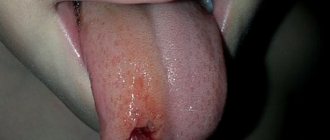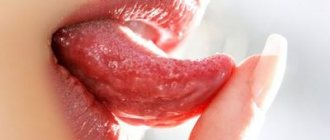A bruise on the tongue is not only unpleasant, but sometimes also very painful. But the worst thing is that upon discovering it, a person invents an incredible illness for himself and becomes emotionally unbalanced. And this can already lead to much more serious consequences. But is a hematoma on the tongue really not dangerous, or can there still be a reason for nerves?
What you need to know about the oral mucosa
The tongue and the mucous membrane around it have 5 main functions. Namely:
- protection;
- suction;
- selection;
- thermoregulation;
- taste perception.
It is the protective function that “monitors” that the negative influence of the environment does not cause harm. But we are talking not only about various viruses and microorganisms, but also about mechanical damage. The mucous membrane withstands irritants of all types: from mechanical to temperature and chemical.
Interesting! The mucous membrane of the mouth is endowed with the fastest regeneration.
Often, it is by the mucous membrane that the doctor can determine whether there are serious disturbances in the body’s functioning or not. Most diseases leave their mark on its condition, for example, in a patient with diabetes mellitus, the tongue will be red, with cracks and erosion. Therefore, any changes in the tongue, and especially a bruise, should cause an urgent visit to the clinic.
Diagnostics
A hematoma is diagnosed by visual examination. If the hemorrhage is located deep under the skin, in internal organs, or in a joint, it is often very difficult to assess its size and possible consequences.
Patients are prescribed an examination, which may include:
- Ultrasound of internal organs, joints;
- computed tomography and magnetic resonance imaging;
- puncture (puncture with a needle): for example, a puncture of the knee joint is often done if there is a suspicion that blood has accumulated in it after an injury.
Hematoma on the tongue: causes
There are three reasons for a bruise on the tongue. If you determine the main one, the doctor will be able to prescribe competent treatment and the problem will disappear in the near future. Among the probable causes of hematoma, the following are worth highlighting.
- Injury to the mucous membrane by mechanical impact on it. Most often, the notorious fish bones and seed husks are to blame.
- Chemical burn. We are not talking about dangerous reagents, but the whole point is overly salted or spicy food. Pepper and salt irritate the delicate mucous membrane, thereby injuring it.
- Thermal exposure is a sip of scalding tea or an ice-cold drink. Most often, they provoke the appearance of hematomas on the tongue.
Oral diseases (glossitis)
Glossitis is an inflammatory disease of the oral cavity that causes changes in the surface of the tongue. The tongue turns red and swells; A white coating, a burning sensation, and growths appear. There are more than 10 types of glossitis and only three of them are characterized by the appearance of cracks on the surface of the tongue.
Folded glossitis.
A congenital anomaly that is determined immediately after birth. Characterized by the presence of cracks of varying depths. Normally, they do not cause discomfort.
Diamond-shaped glossitis.
The affected area is diamond-shaped and has cracks in the middle of the tongue. Most often appears with gastritis with low acidity.
Desquamative glossitis.
It is sometimes called “geographical” because the lesions resemble the outlines of continents. Damaged areas can “move” on the surface of the tongue, almost always causing pain, burning, and shallow cracks. The reason for the appearance of such glossitis is still not clear. Some argue that this is an allergic reaction, others that it is a hormonal imbalance and gastrointestinal diseases.
Type of hematoma based on fluid color
Even before going to the doctor, you can determine the degree of injury and the duration of wound healing based on the color of the liquid in the hematoma. The content may be as follows:
- a milky white tint indicates that the wound is of a superficial type, where the vessels were not affected. There is no blood in the ulcer, only serous fluid. Such injuries heal the fastest;
- red color indicates a fairly deep injury; it is possible that a muscle is affected. Such wounds take longer to heal, the reason being that the blood is much more difficult to absorb. What complicates the situation is that this environment is attractive to various types of microorganisms. It's no secret that the mouth is the dirtiest place in the body. It is in the oral cavity that contains a large number of microorganisms that can cause inflammation.
If the blood bruise is located on the side of the tongue, then this may be a symptom of a dangerous disease: stomatitis, problems with the gastrointestinal tract, disruptions in the endocrine system. This is why you should not put off going to the doctor.
Symptoms
A bruise on the skin is always clearly visible. At first it has a purplish-blue color, and then begins to “bloom”, acquiring yellow and green colors. If a sufficiently large amount of blood accumulates under the skin, a protruding lump forms. At first it is very painful to feel, but later the pain goes away.
The outpouring of blood into the internal organs and into the substance of the brain is preceded by trauma. The main symptom is pain. In this case, the hematoma is not visible externally. If bleeding continues, the victim becomes pale, weak, and dizzy. With chronic internal bleeding, anemia comes to the fore. Bleeding in the brain is especially dangerous. Compression of brain structures may occur, sometimes leading to death.
Correct treatment
Eliminating the cause means curing the disease faster. This statement is truer than ever. But only if the cause is not a serious illness. It is clear that large hematomas take longer to disappear than small ones. Despite this, even a tiny bruise can be a reason to go to the clinic. The fact is that in order to avoid serious consequences, surgical intervention is sometimes necessary, during which the hematoma is removed. When contacting a doctor, it is better to choose an oral and maxillofacial surgeon.
In order for the hematoma to go away faster, you need to maintain oral hygiene, namely:
- brush your teeth after and before bed, and preferably after every meal;
- if you cannot brush your teeth after eating, chewing gum can perform hygienic cleaning, removing food particles;
- Rinse your mouth with antiseptic solutions several times a day.
It must be said that only the attending physician prescribes treatment methods for a bruise. True, most often it is the most common and is based on rinsing. Only if the hematoma grows or conservative treatment fails, something more serious is used.
How to treat a blood bladder?
General therapy
Depending on the type of pathological condition that caused the appearance of a blood bubble in the mouth, treatment can be carried out with the following medications:
- In case of traumatic formations that go away on their own over time, the oral cavity is treated with antiseptic agents
For candidal stomatitis, antifungal drugs such as Levorin and Nystanin are effective.
- For diseases of viral etiology, the treatment regimen includes Viferon, Amoxicillin, Tsiprolet, Azithromycin.
- To combat gingivostomatitis, where it is expected to remove areas affected by necrosis, antiallergic medications, antibacterial agents, and vitamin complexes are used.
- In case of traumatic formations that go away on their own over time, the oral cavity is treated with antiseptic agents. If there is pain, the doctor may prescribe Cholisal, Ketoprofen, Voltaren, Lornoxicam, Kamistad.
- To eliminate tuberculosis, appropriate chemotherapy is prescribed, which includes Rifampicin, Ioniazid, Pyrazinamide.
Local therapy
To speed up the healing process, regularly rinse with antiseptic agents. Furacilin, Chlorhexidine, Stomatidine, Betadine, Miramistin, hydrogen peroxide solution, Iodoform, Chlorophyllipt show good results.
Treatment of the affected tongue with disinfectant solutions should be performed twice a day, at a minimum, but before that you must brush your teeth and remove any remaining food.
It is advisable to eat food after the procedures within 30-60 minutes, which will significantly increase their effectiveness.
Traditional methods
Aloe or Kalanchoe juice has a wound healing effect
To alleviate the condition, it is good to use healing decoctions based on chamomile, sage, yarrow, St. John's wort, and viburnum fruits.
They are prepared at the rate of 1 tbsp. herbal raw materials per 1 glass of water.
The mixture is brought to a boil and left for 2-3 hours to infuse. Before use you need to strain.
Aloe or Kalanchoe juice has a wound-healing effect.
Oil from sea buckthorn and rosehip also has the same property. They are applied directly to the affected area.
These agents accelerate the regeneration process, prevent the proliferation of pathogenic microorganisms and anesthetize the lesion.
A solution prepared from salt (1 tsp), 3 drops of iodine and soda (1 tsp) is a universal remedy in the fight against inflammatory processes in the oral cavity.
These components are mixed in one glass of warm boiled water and used for lotions and rinses. It is also good to treat the affected areas with hydrogen peroxide.
Useful tips
Found a hematoma in your mouth? It would be helpful to do the following:
- give up irritating foods: salty, smoked, spicy, etc.;
- rinse your mouth with antiseptic drugs;
- make an appointment with a doctor and be sure to visit him if hematomas appear;
- adhere to medical recommendations.
In addition, when identifying a hematoma on the tongue (blood or regular), you cannot:
- pierce it so that it heals faster (you must remember that it is easy to get an infection into the wound);
- injure in any other way;
- refuse to go to the doctor in the hope that everything will go away on its own;
- panic and invent dangerous diseases and their symptoms.
Other reasons
- Avitaminosis.
A deficiency of microelements can cause sensitivity of the mucous membranes and the appearance of cracks in the tongue. - Allergy.
New dental care products and foods can cause increased sensitivity of the gums and tongue. - Worms.
The presence of parasites leads to the fact that the body does not absorb nutrients and beneficial microelements, which causes the condition of the mucous membrane to worsen. - Hormonal disbalance.
- Stress.
How to determine health status by language. Source: Yulianna Pliskina YouTube channel
Dangerous consequences
The most common complication that can occur as a result of a hematoma is infection in the wound . If you do not pay attention to this in time, an inflammatory process begins, accompanied by fever, increased temperature, weakness, loss of consciousness and other dangerous symptoms. Moreover, this can harm not only the oral cavity, but the entire body. Although most often, as a result of a bruise, a person simply loses his sense of taste and appetite. It must be said that if the above symptoms are accompanied by numbness of the tongue or jaw and speech impairment, then you need to urgently call an ambulance or go to the clinic yourself.
Most often, bruises occur on children's tongues. Kids are in a hurry, play around, bite themselves or get injured, for example, with a fork. True, adults are not protected from such damage either. Be that as it may, everyone in such situations needs to consult a doctor, and then adhere to the above treatment recommendations. Then the bruise will disappear in a matter of days and without complications.
Additional measures to prevent hematomas
To reduce the risk of blood balloons swelling on the oral mucosa, patients are advised to follow a few simple rules:
- avoid salty and spicy foods that irritate the mucous membranes;
- adjust the design of prostheses and orthopedic systems for the jaw apparatus;
- increase the amount of medium-temperature liquid and semi-liquid foods in the diet
We should also not forget about the need to regularly visit the dentist for the timely detection and elimination of diseases of the teeth and gums. This solution will help maintain oral health and avoid a number of serious pathologies with unpleasant symptoms.
Inflammation of the salivary glands
This disease is called sialadenitis. Any salivary glands can be affected by it, but painful sensations in the tongue, closer to the base, occur if the sublingual gland is affected. Pathology is caused by viruses or bacteria. Symptoms of sialadenitis include:
- pain at the base of the tongue;
- the formation of a compacted swelling underneath;
- decreased salivation.
How to treat the disease if the tongue hurts on the side precisely for this reason? Antibacterial and antiviral drugs.
What you should absolutely not do
If blood appears on the tongue, it means there is an open wound on its surface. In order not to aggravate the situation and not provoke the development of inflammatory processes, it is important to adhere to some restrictions. So, if you inadvertently injured the main speech organ, refrain from the following actions:
- cauterizing the wound with alcohol - this will only further injure the mucous membrane,
- drinking hot tea will increase bleeding,
- treating the wound with brilliant green or iodine,
- pressing the wound with a bare finger or teeth, trying to stop the bleeding by pressing the tongue to the roof of the mouth.
Until the bleeding has completely stopped, do not eat or put anything foreign in your mouth until the wound has completely healed. It is also strictly forbidden to self-medicate with antibacterial drugs - they can only be prescribed by the attending physician.










